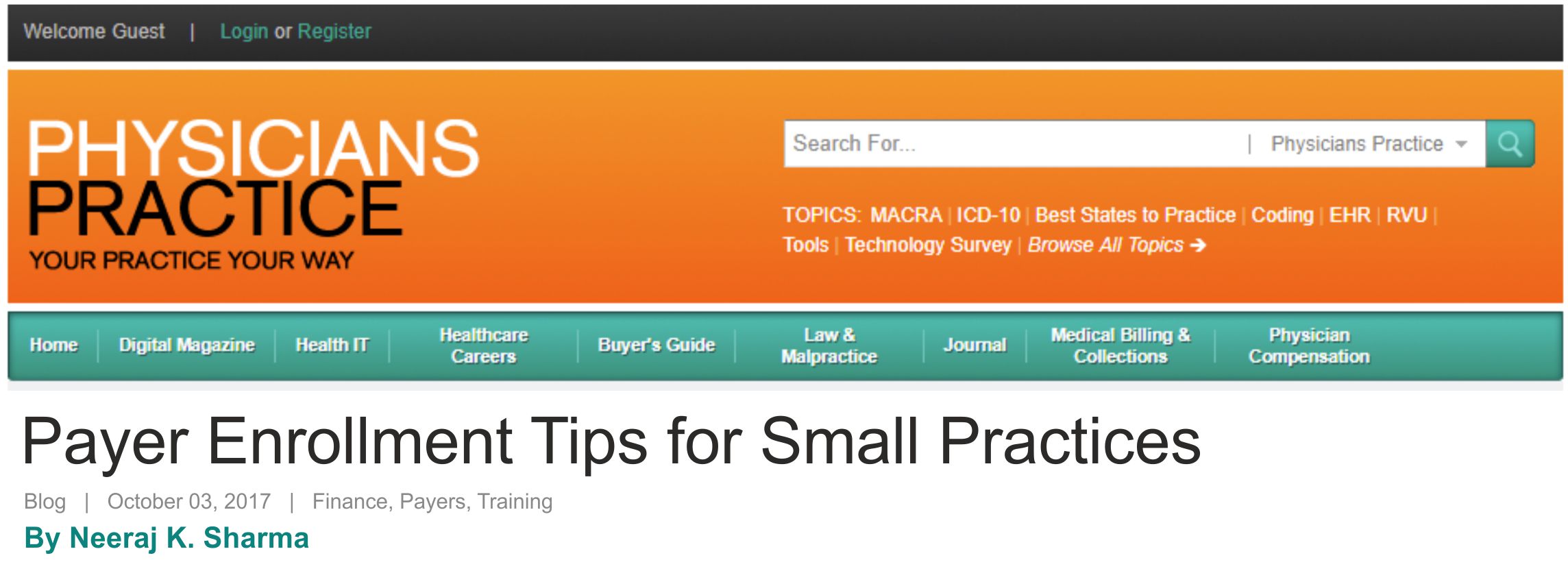
\r\n<---p>
Shrinking reimbursement from payers is on a collision course with rising out-of-pocket responsibility for patients. Last year, Physicians Practice<---em>\r\n reported that independent physicians are often reimbursed 20 to 30 \r\npercent less for certain CPT codes. While the reasons may vary, the \r\nbroader lesson is that these providers must pay sharper attention to \r\nmanaging payer relationships and tightening up wherever they can. There \r\nis no cushion to fall back on, even if patients increasingly pay more \r\nfor their care. The reality is they struggle to do so.<---p> This\r\n makes maintaining payer relationships even more imperative. Should a \r\nprovider be dropped from a plan, it would be folly to hope the patient \r\ncould pay in full for any remaining treatment. To that end, the \r\nindependent practice must lessen revenue dependence on a relative \r\nhandful of payers--and instead, sign up with more plans to grow their \r\npractice and revenue.<---p> To do so without \r\nalso growing their administrative headaches, practices should consider \r\nusing a newer platform and services. One such option is an online, \r\nsubscription-based service for credentialing and onboarding. Bolstered \r\nby these services, physician practices can adopt the following \r\nstrategies to reap more revenue, more efficiently, from health plans.<---p> Centralize provider data<---strong><---p> The\r\n information providers need to join a new health plan often resides in \r\ndifferent files, folders and with different employees. Nothing slows \r\ndown enrollment in another plan more than an extended chase for \r\napplications, licensing and credentialing forms, and any of the myriad \r\nof documents payers require. Compounding this chase is the typical high \r\nturnover of front desk personnel that many practices rely on to stay on \r\ntop of enrollment and re-credentialing. But they aren##$$##t—which is why \r\nmany practices are enrolled in fewer health plans than they could be. \r\nIt##$$##s just too cumbersome to do on a regular basis.<---p> One\r\n of the biggest benefits of an online credentialing service is that it \r\ncentralizes all the documentation in one location. The best services \r\nload this hub with all the most current forms required by almost every \r\npayer and health plan. This centralized location will include the right \r\ncontacts for each payer, and information that cuts significant time from\r\n the onboarding process. It can also store the subsequent payer \r\ncontracts, for easy lookup when needed.<---p> The\r\n upshot: every authorized person at the practice has access to all \r\ninformation, in one convenient location, needed to join and remain in a \r\nplan.<---p> Stay ahead of deadlines<---strong><---p> There are so many important deadline dates for practices to remember that inevitably they forget some of the most important.<---p> This\r\n is an unacceptable reality for physicians and patients alike. An online\r\n credentialing service can bring order to chaos, tracking status and \r\nsending automation notifications when expiration dates are looming for \r\ncredentialing applications, license, malpractice renewal and more.<---p> Position for continuous, efficient communication with payers<---strong><---p> While\r\n some online credential services perform all the above functions, not \r\nall are tapped into a wider network of payers and providers across the \r\ncountry. Those that are can help small practices steadily automate more \r\ncommunication processes with payers. One of the most important is \r\ncommunicating provider directory updates—which payers are mandated to \r\nask for. As such, providers are getting inundated with these requests. \r\nIf they can##$$##t fulfill them on a timely basis, they will inevitably be \r\nincorrectly listed in a directory, which could prevent them from seeing \r\nmore patients. <---p> In short, it##$$##s to the \r\nprovider##$$##s benefit to be accurately listed on the payer##$$##s list of member\r\n providers. Those online credentialing services that enable mass \r\nprovider directory updates, re-credentialing and more can whittle the \r\nprovider##$$##s administrative time even further.<---p> Finally,\r\n it matters to think not just in terms of enrolling, but also renewing. \r\nInformation must stay updated and readily accessible when the time to \r\nre-credential rolls back around. With an online subscription process, \r\nthe process won##$$##t entail another protracted chase for the right \r\ninformation.<---p> It is becoming paramount \r\nthat such frustrating drudgery comes to an end. Study after study is \r\nconnecting severe physician burnout with documentation and \r\nadministrative overload. That##$$##s one more challenge to add to a list that\r\n includes shrinking reimbursement and the rise of high deductible plans \r\nthat leave patients scrambling to pay for care.<---p> While\r\n reducing documentation won##$$##t solve all of healthcare##$$##s problems, it \r\nwill mitigate one of the biggest - poor provider and payer relationships\r\n - and put the small practice back on sound financial footing.<---p> Neerak K. Sharma <---strong>is\r\n the Chief Operating Officer at Santéch Solutions, whose groundbreaking \r\nsolutions I-Enroll, I-Network, and I-NetXchange liberate providers and \r\npayers from the onerous paper documentation associated with managing \r\ntheir relationships.<---em><---p>\r\n\r\n <---p>